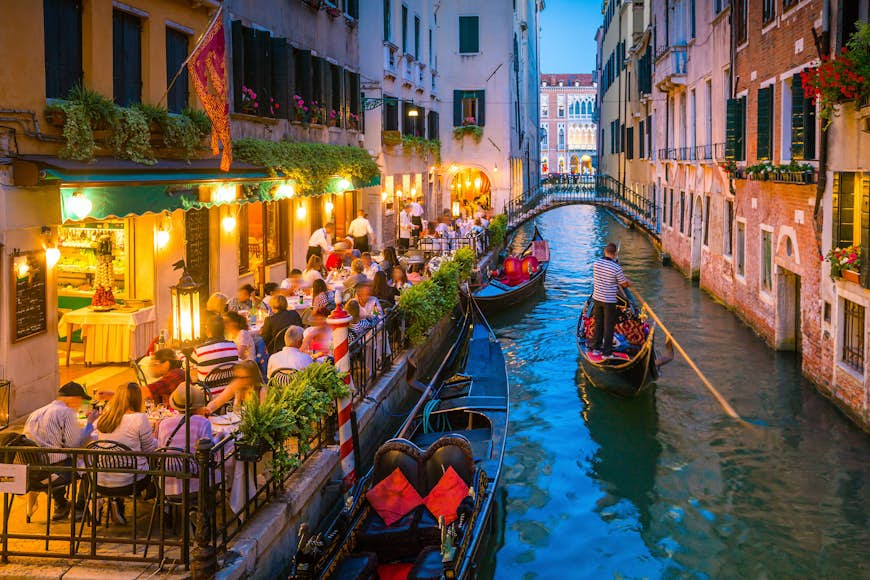Venice's transportation system is unique. When the streets are actually waterways, there will be some changes to what one considers common ways of public transport.
It takes some getting used to, as well as adaptability and the knowledge that moving around Venice and the islands of the Lagoon doesn't come cheap, but our top tips are here to make it all simpler. There is a lot to know about Venice's transportation.
Get more travel inspiration, tips and exclusive offers sent straight to your inbox with our weekly newsletter.
The best way to get around Venice is by walking. Going from the Santa Lucia railway station to Saint Mark's Square will take you 30 minutes on foot. It's main sights are easy to find and are marked on the map.
You can discover hidden corners and squares if you walk along the canals. The city deploys walkways in case the streets get flooded, but if you want to visit in autumn, you should have some rain boots.
Vaporettos are a staple of the lagoon. Where normal cities have buses, the Serenissima has something called water buses. The six sestieri and the other islands of the lagoon are connected by the vaporetto service. The city center lines 1 and 2 which sail along the Grand Canal are relevant to tourists.
A single ticket, valid for 75 minutes, costs 7.50, and it is better to buy your ticket before you board to avoid the additional fee. You can purchase passes for a single day, two days, three days or seven days for 20, 30, 40 and 60.

There is a traghetto that allows people to cross the Grand Canal from one side to the other. There are several places along the Canal where you can take the ferry to the other side. The service is not open on holidays and city festivals.
Like any other city, Venice has its own taxi service. If you want to get to your destination quickly, water taxis are a good choice, but keep in mind that they are probably the most expensive means of transportation available. Water taxis can carry up to ten people, so if you have enough you could split the fare.

The gondola is more than just a way to get around the city, it's an experience as well. You can expect to pay between 80 and 100 for a half-hour tour by day and between 100 and 120 for a night tour, depending on the route you choose. It is always a good idea to share a gondola, but they can't carry as many people as a water taxi.
The Lido is the starting point for the ferry service, which goes on to connect Venice to the wider Lagoon area. If you want to take your own ride with you, the ferry is an excellent option.

The main function of buses is to connect Venice to Mestre on the mainland and then travel around Mestre itself. The Santa Lucia railway station is close to Piazzale Roma, which is where some lines reach into Venice. You can buy a ten- ticket carnet for 14 if you buy a single ticket.
If you want to stay in Mestre instead of on the Lagoon, you can take the two tram lines. One of them, T2, goes only to the mainland, while the other, T1, goes to Piazzale Roma. A single ticket is 1,50 while a ten ticket carnet is 14
The canals, narrow streets, and no buses make Venice a very user-friendly destination for travelers with access needs. Even if there is always room for improvement, the Serenissima is willing to dismantle architectural barriers.
A pool of experts, including people with disabilities who live in Venice, have created a collection of barrier-free routes that can be found on the city's official website.
Vaporettos should be equipped in a way that allows everyone to board, even if there are some issues caused by a high tide. While a companion is free of charge, most vaporettos can transport up to four wheelchairs for 1.50.
Water taxis and shuttles leave from the airport. The buses leave every 30 minutes.
The airport buses will take you to PiazzaleRoma. There are buses going to and fro from Santa Lucia station.
Vaporetti are small passenger ferries that leave Piazzale Roma docks.
The train station Vaporetti leaves from the docks.
You can transfer from Venezia Mestre to Venezia Santa Lucia.
Taxis and vaporetti leave from the waterfront if the passengers are shuttled into Venice by a cruise liner.
About 2 hours ago, this article was updated.